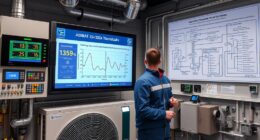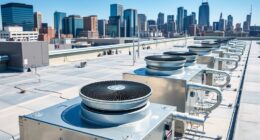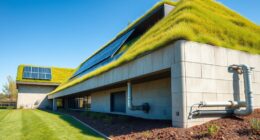Integrating heat pumps with energy recovery ventilators (ERVs) enhances your building’s energy efficiency and indoor comfort. Heat pumps manage heating and cooling by leveraging ground or ambient temperatures, while ERVs supply fresh air and recover energy from exhaust air. Together, they optimize airflow, reduce utility costs, and improve air quality. Proper design, installation, and maintenance are key to maximizing benefits. If you want to explore how these systems work together, there’s more to discover.
Key Takeaways
- Proper system design ensures heat pump and ERV components work together for optimal energy efficiency and indoor comfort.
- Correct ductwork integration and sealing prevent airflow issues and maximize heat transfer between systems.
- Regular maintenance of filters, vents, and performance monitoring maintains system efficiency and prolongs lifespan.
- Combining heat pumps with ERVs reduces energy costs by recovering thermal energy during ventilation.
- Smart controls and zoning optimize operation, balancing indoor air quality, temperature, and energy use.
Understanding the Basics of Heat Pumps and ERVs
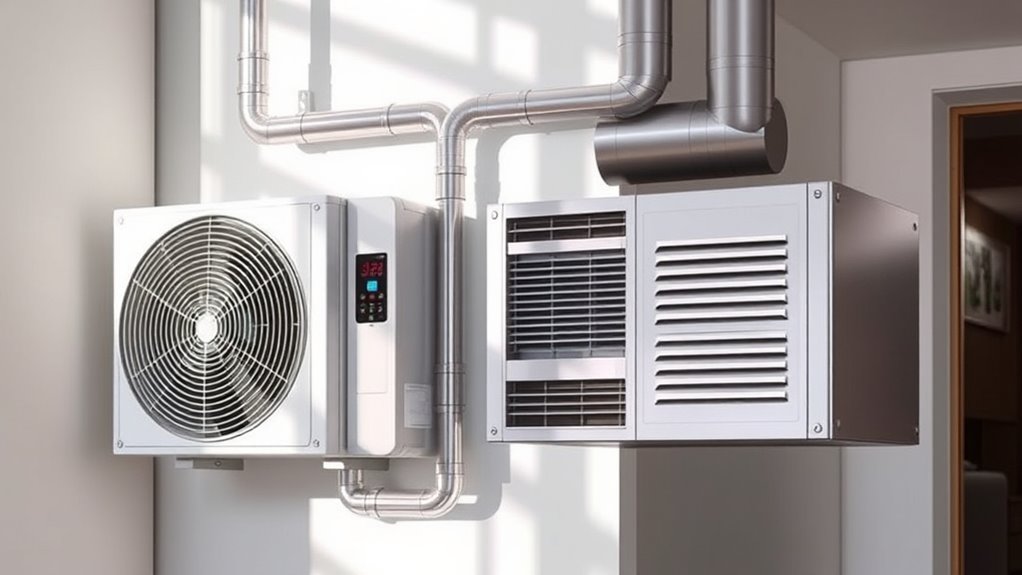
Heat pumps and energy recovery ventilators (ERVs) are essential components of modern, energy-efficient heating and ventilation systems. You’ll find that heat pumps can be used in geothermal applications, harnessing the stable underground temperature to provide efficient heating and cooling. They’re also compatible with solar energy systems, allowing you to supplement power and reduce reliance on the grid. ERVs work by exchanging indoor and outdoor air while recovering energy from exhausted air to pre-condition incoming fresh air. Together, these systems optimize energy use and indoor comfort. Understanding their basic functions helps you appreciate how they contribute to sustainable building design. By combining geothermal and solar compatibility, you maximize efficiency and lower energy costs, making your system both eco-friendly and cost-effective. Adhering to building codes and regulations ensures safe and compliant installation of these advanced systems.
The Advantages of Combining Heat Pumps With ERVS

By integrating heat pumps with energy recovery ventilators, you can appreciably boost your building’s energy efficiency and indoor comfort. This combination enhances ventilation strategies by optimizing heat transfer and reducing energy loss, which lowers utility costs. Additionally, it maintains excellent indoor air quality by continuously exchanging stale air with fresh, filtered air. The heat pump recovers thermal energy from outgoing air, preconditioning incoming air, and reducing strain on your heating and cooling systems. This synergy not only conserves energy but also creates a healthier environment by controlling humidity and removing pollutants. Proper ventilation strategies are essential for ensuring optimal indoor air quality and energy efficiency. Overall, combining heat pumps with ERVs streamlines your building’s climate control, improves ventilation, and ensures a more comfortable, healthier indoor space.
Key Components and How They Interact
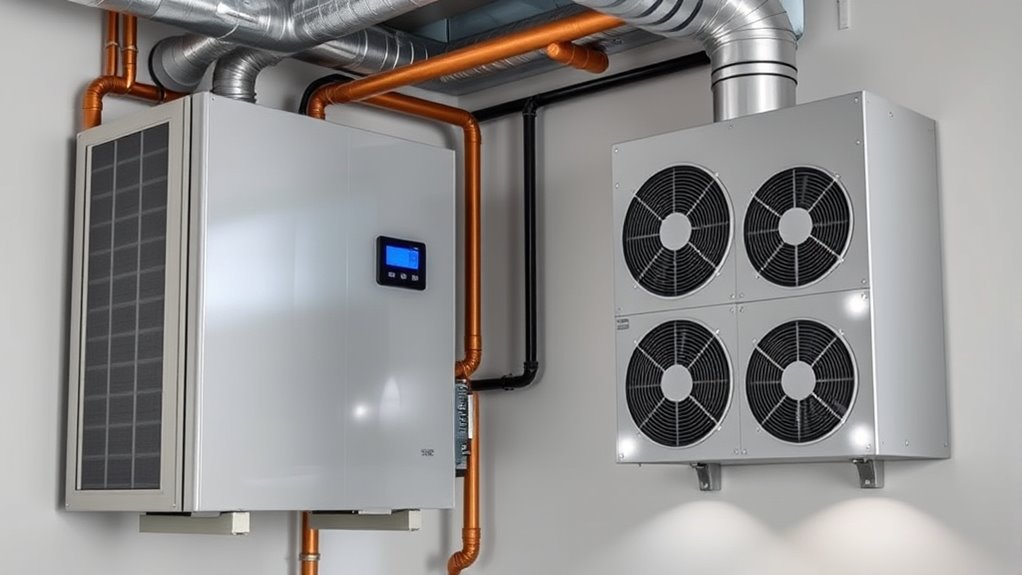
Understanding the key components involved in integrating heat pumps with energy recovery ventilators is essential for optimizing their performance. The main components include the heat pump unit, the energy recovery ventilator core, and ductwork that connects them. The heat pump efficiently transfers heat between indoor and outdoor air, improving overall heat pump efficiency. The ERV core exchanges heat and humidity between incoming and exhaust air streams, maintaining proper ventilation rates while conserving energy. These components work together to balance indoor air quality and energy use. Proper interaction guarantees that heat is recovered effectively while the heat pump adjusts to changing conditions. Additionally, proper system design ensures that all components operate harmoniously for maximum efficiency. When these components are correctly integrated, you’ll experience enhanced comfort, better ventilation, and energy savings.
Designing an Integrated System for Your Home or Building

When designing an integrated system for your home or building, it’s essential to assess your specific heating, cooling, and ventilation needs. Start by evaluating your comfort preferences and the building’s insulation, which influence system capacity. Incorporate smart thermostats to optimize energy use and maintain consistent temperatures efficiently. Prioritize indoor air quality by selecting a system that balances heat pump performance with energy recovery ventilators, ensuring fresh, clean air circulates while minimizing energy loss. Consider zoning options for different areas to enhance comfort and efficiency. Properly managing air quality and ensuring adequate ventilation can prevent issues related to indoor pollutants and humidity. Tailor the system to your lifestyle, factoring in occupancy patterns and air quality requirements. A well-designed, integrated setup improves energy savings and indoor comfort, making your home more sustainable and healthier.
Installation Considerations and Best Practices
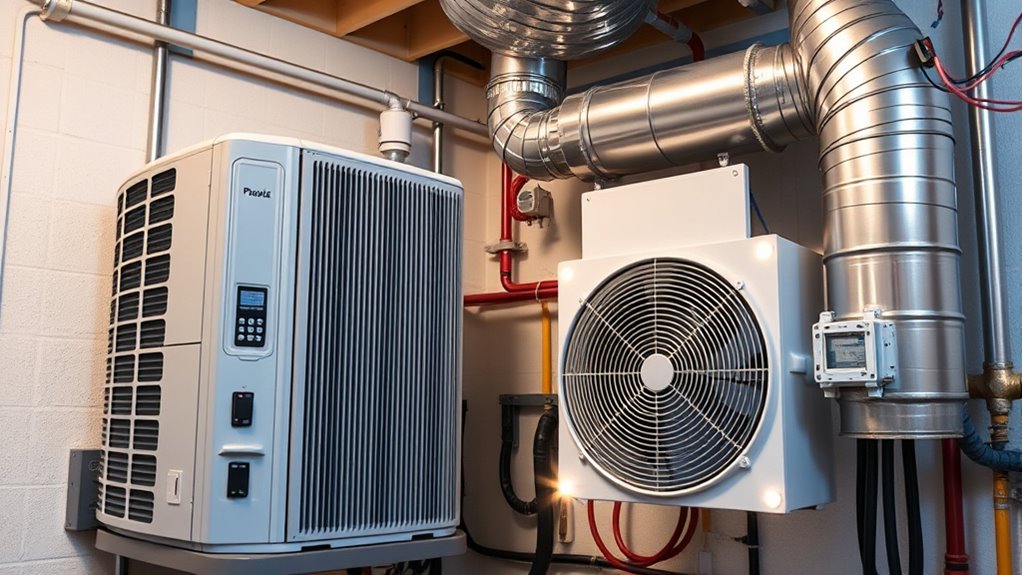
Proper installation is critical to guarantee your heat pump and energy recovery ventilator operate efficiently and reliably. Focus on ideal placement, ensuring adequate clearance and accessibility. Use proper thermal insulation around ducts and equipment to minimize energy loss. Implement zoning strategies to control airflow and temperature effectively in different areas. This prevents short cycling and improves comfort. Properly sealed ductwork, especially at joints, enhances efficiency. Consider airflow balancing to maximize system performance. Ensure electrical connections meet code standards for safety. Lastly, verify that the system is level and secure to avoid operational issues. Use the table below to guide key installation considerations:
| Aspect | Best Practice | Benefit |
|---|---|---|
| Thermal Insulation | Insulate ducts and equipment thoroughly | Reduces energy loss |
| Zoning Strategies | Design zones for targeted control | Increases comfort and efficiency |
| Duct Sealing | Seal all joints and leaks | Improves airflow and system performance |
| System Leveling | Ensure equipment is level during installation | Prevents operational issues |
Additionally, paying attention to proper airflow management during installation can significantly enhance overall system performance and longevity.
Energy Efficiency and Cost Savings Potential
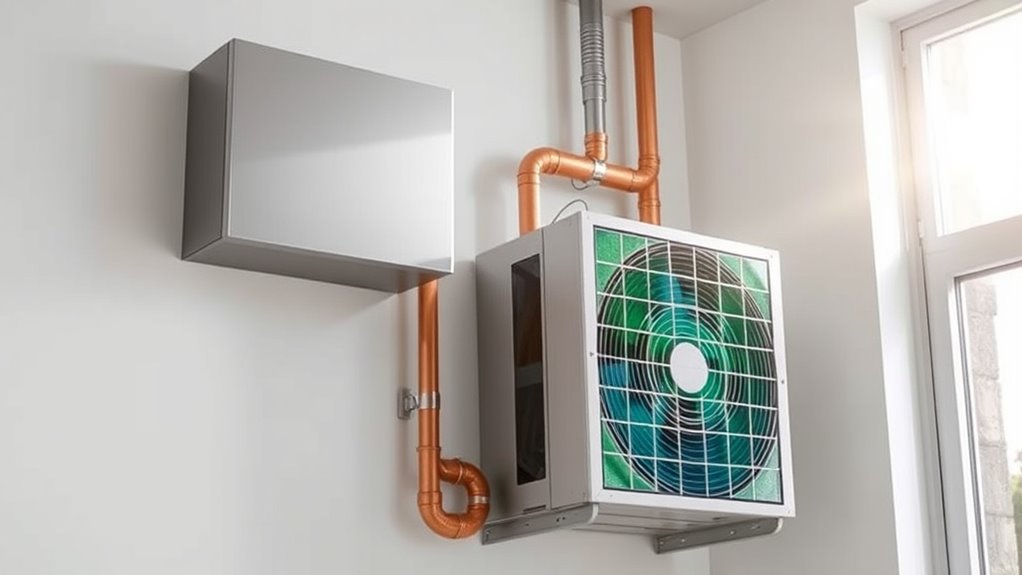
Integrating heat pumps with energy recovery ventilators can markedly boost your home’s energy efficiency and reduce long-term costs. By combining these systems, you benefit from a significant cost benefit through lower energy bills, as heat pumps efficiently transfer heat, reducing the need for additional heating or cooling. The energy recovery ventilator minimizes waste by reclaiming heat from exhausted air, further cutting energy consumption. This integration not only saves you money but also reduces your environmental impact by decreasing greenhouse gas emissions. Over time, the upfront investment pays off through lower utility bills and enhanced comfort. Overall, this synergy offers a smart way to optimize your home’s energy use while supporting sustainability and long-term savings.
Maintenance and Troubleshooting Tips
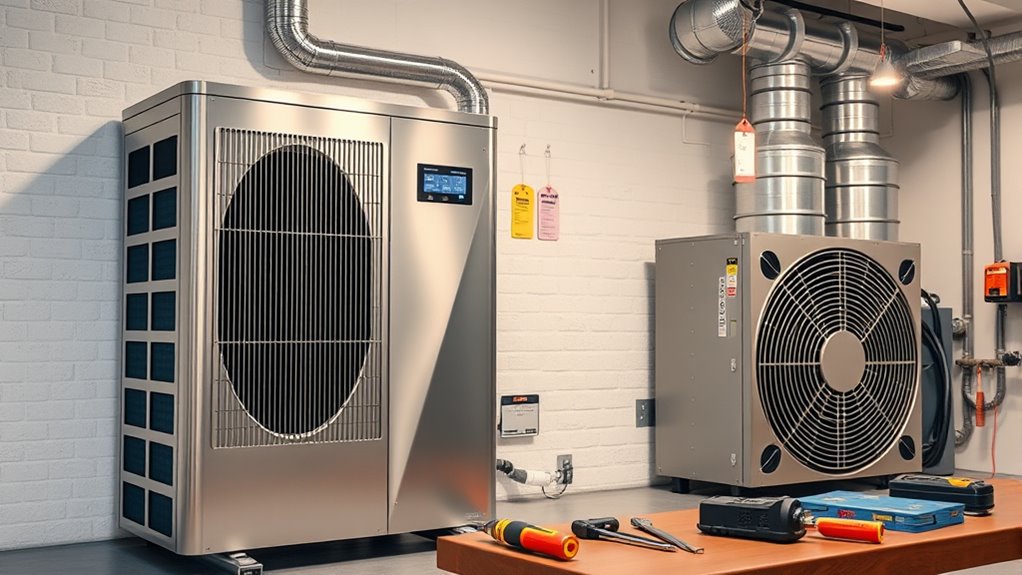
To keep your system running smoothly, you should regularly check and replace filters as needed. Monitoring system performance helps you catch issues early before they become costly repairs. If problems arise, addressing common issues quickly can save you time and maintain your system’s efficiency. For additional support, consider consulting system troubleshooting tips to resolve specific concerns promptly.
Regular Filter Checks
Regular filter checks are essential to keep your heat pump and energy recovery ventilator running efficiently. You should inspect the air filter regularly for dust accumulation, which can restrict airflow and reduce system performance. A dirty filter forces your system to work harder, increasing energy consumption and wear. To prevent this, remove the filter and check for visible dirt or debris. If it’s clogged or dusty, replace or clean it according to manufacturer instructions. Keeping filters clean ensures proper airflow, improves indoor air quality, and prevents strain on your equipment. Regular checks also help you catch potential issues early before they cause system failure. Make it a habit to examine filters monthly, especially during heavy use seasons, to maintain peak operation and prolong your system’s lifespan. Additionally, understanding how automation technologies can optimize system maintenance may further enhance your system’s efficiency.
System Performance Monitoring
Monitoring your system’s performance regularly helps you catch issues early and guarantee everything runs smoothly. Keep an eye on humidity control and noise levels, as these are key indicators of excellent operation. Regular checks ensure the heat pump and ERV work harmoniously, maintaining comfort and efficiency. Use the table below to track performance aspects:
| Maintenance Task | What to Watch For |
|---|---|
| Humidity Control | Proper moisture levels, avoid excess |
| Noise Reduction | Unusual sounds, vibrations |
| System Efficiency | Cooling/heating output, energy use |
| Filter and Vent Checks | Clean filters, unobstructed vents |
Consistent monitoring helps you identify performance dips early, keeping your system running smoothly and quietly. Additionally, inspecting for proper sound quality can help detect early issues with the sound levels or vibrations that may affect overall system performance.
Addressing Common Issues
Even well-maintained heat pumps and energy recovery ventilators (ERVs) can encounter common issues that affect performance. One frequent problem is ventilation noise, which can be distracting or indicate airflow restrictions. To rectify this, check for loose panels or debris blocking vents. System compatibility also plays a role; if the heat pump and ERV aren’t properly matched, you might experience reduced efficiency or operational hiccups. Confirm your components are designed to work together and installed correctly. If you notice unusual sounds or performance drops, consult the manufacturer’s guidelines or a professional technician. Regular maintenance, including filter changes and duct inspections, helps prevent these issues, ensuring your integrated system runs smoothly and quietly. Additionally, understanding system compatibility can help you troubleshoot and optimize the performance of both units.
Case Studies of Successful Integrations

Several building projects have successfully integrated heat pumps with energy recovery ventilators, demonstrating their practicality and efficiency. In one commercial office, smart thermostats optimize heating and cooling, ensuring the system responds dynamically to occupancy patterns, which enhances indoor air quality. Another residential development used this integration to maintain consistent comfort while reducing energy bills. These projects highlight the importance of combining advanced controls with efficient ventilation, leading to healthier indoor environments. By leveraging smart thermostats, occupants gain better control over temperature and air quality, resulting in increased comfort and well-being. Additionally, understanding divorce statistics can help architects and planners consider demographic trends when designing sustainable and adaptable building solutions. These case studies prove that integrating heat pumps with energy recovery ventilators isn’t just effective but also scalable across different building types, making it a smart choice for sustainable, healthy spaces.
Future Trends and Technological Advancements
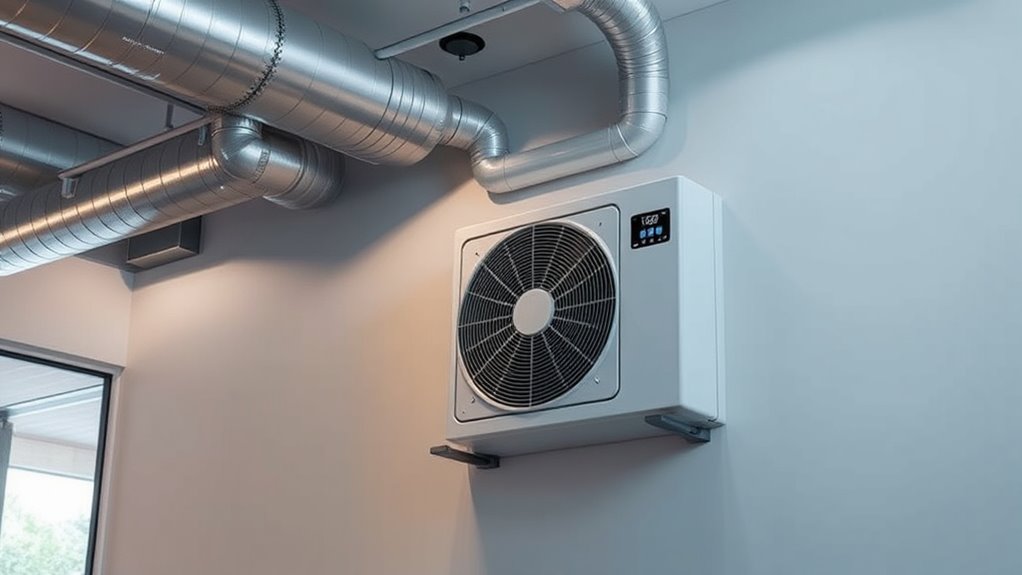
As technology continues to evolve, future trends in integrating heat pumps with energy recovery ventilators promise to enhance efficiency and user experience. Smart grid technology will play a pivotal role by enabling dynamic energy management, optimizing system performance, and reducing costs. You can expect more intelligent controls that adapt to occupancy patterns, weather conditions, and energy demand. Additionally, advancements will focus on renewable integration, allowing these systems to seamlessly incorporate solar or wind energy sources. This will reduce reliance on fossil fuels and improve sustainability. Enhanced sensors and automation will make systems more responsive, ensuring better indoor air quality and energy savings. Overall, these technological advancements will make integrated heat pump and ERV systems smarter, more efficient, and better aligned with future energy landscapes.
Frequently Asked Questions
How Do Heat Pumps and ERVS Impact Indoor Air Quality?
You might wonder how heat pumps and ERVs affect indoor air quality. These systems improve ventilation efficiency by continuously exchanging stale indoor air with fresh outdoor air. Heat pumps also regulate temperature and humidity, creating a healthier environment. Together, they reduce indoor pollutants, prevent mold growth, and maintain ideal indoor air quality. Proper integration ensures you breathe cleaner air while enjoying energy savings and comfort in your space.
What Are the Common Challenges in Integrating These Systems?
You face challenges like system compatibility issues, installation complexity, and balancing performance. Ensuring the heat pump and ERV work seamlessly requires careful planning and precise integration. You might encounter difficulties syncing controls and optimizing energy efficiency. Additionally, installation complexity can increase costs and time. To overcome these, thorough assessment, expert installation, and proper system design are essential, helping you achieve a reliable, efficient, and comfortable indoor environment.
Can Existing HVAC Systems Be Upgraded With Heat Pumps and ERVS?
You can upgrade your existing HVAC system with heat pumps and ERVs, but you’ll need to consider system compatibility and retrofit considerations. Make certain your current system can support these components, and evaluate if the upgrades will integrate smoothly. Sometimes, you might need to modify ductwork or electrical setups. Consulting a professional helps determine if your system is suitable and guides you through the best retrofit options for efficiency and performance.
Are There Specific Climate Conditions That Favor This Integration?
Imagine you’re in a cold climate where maintaining indoor comfort is challenging. In such regions, integrating heat pumps with ERVs offers notable benefits because of their climate adaptability. These systems work efficiently in moderate to cold conditions, providing regional benefits like energy savings and improved ventilation. This integration is especially advantageous where seasonal temperature swings demand flexible, energy-efficient solutions, making it a smart choice for enhancing heating and ventilation performance.
How Do Maintenance Routines Differ for Combined Systems?
When maintaining combined systems, you’ll find your routines differ from standalone units. You need to regularly check and replace filters to keep airflow ideal, and guarantee system calibration is accurate for efficiency. It’s also important to inspect the heat pump and ERV components for wear and tear. Scheduling these tasks consistently helps prevent breakdowns, maintain indoor air quality, and maximize system performance.
Conclusion
By thoughtfully integrating heat pumps with energy recovery ventilators, you open the door to a more harmonious and efficient living environment. This approach subtly balances comfort and sustainability, gently guiding your home toward greater energy mindfulness. Embracing these technologies not only enhances your space but also fosters a quiet confidence in your commitment to smarter, greener choices. Ultimately, such integration invites a future where comfort and conservation coexist with effortless elegance.





